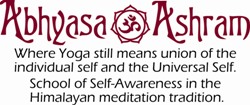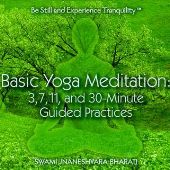|
|
Swami Jnaneshvara Bharati Spirit of Learning Our community of meditation and contemplation is devoted to training and nurturing those who deeply long for the direct experience of union with the eternal, pure center of consciousness, the bliss of being that is one with the absolute reality, as the wave who seeks to remember it is one with the ocean. One word for that union is "Yoga." (See Self-Realization) Yoga is traditionally taught, practiced and learned through a close relationship between the individual mentor and mentee, teacher and student, in a community of noble friends, known as kalyana-mitra. Guru is a force-field driven by grace, a stream of knowledge of direct experience which, though it may operate through a person, is itself not a person. The word "Abhyasa" means "practices." Abhyasa is purposefully choosing to do that which leads to "sthitau," which is a stable, steady, undisturbed inner calmness or tranquility. Abhyasa is one of the twin foundations of Yoga, along with Vairagya, the mental stance of non-attachment (Yoga Sutras 1.12-1.16). The root of the word Ashram is "shrama," which means "effort" or "striving." The hermitage or home of a swami or other person serving people in their efforts towards inner peace and spiritual awakening is called an Ashram. Thus, our community of meditation, contemplation and learning is known as Abhyasa Ashram. More than any physical location (especially given its relatively small size), it is really a place of the heart, an inner sanctuary of silence. If you would like to see what we're doing in the physical location, please take a look at the ashram website. SCHEDULE: Click here for activities schedule. DONATIONS to Abhyasa Ashram:
The spirit of our training is captured in an Indian tale of a seeker who went to a great sage asking to be a student on the path of Self-realization:
Before we can truly be a teacher, we have to be a student. Thus, the emphasis of our training is on being a student of the principles and practices, not a teacher. Ours is not a modernized, watered-down "yoga teacher training program". Those who participate in our "student/aspirant" training will surely feel qualified not only to practice and progress on the path, but also to share with and teach others what has been learned and practiced, as have others who have already studied and practiced with us in this way. May your meditation today bring you peace, happiness, and bliss. In loving service, Swami J -------
|
|

